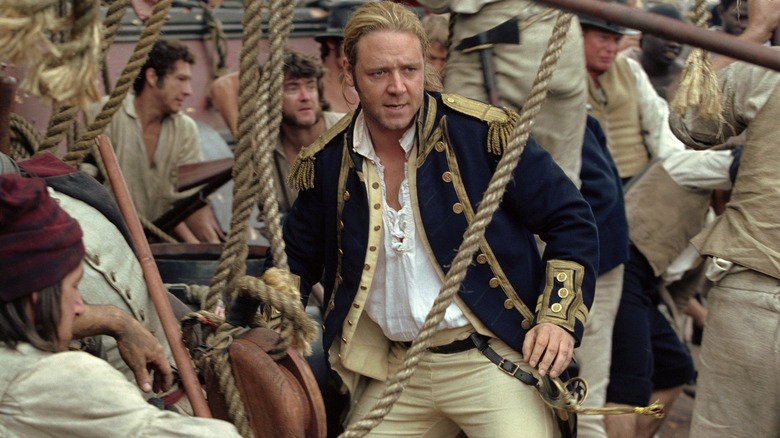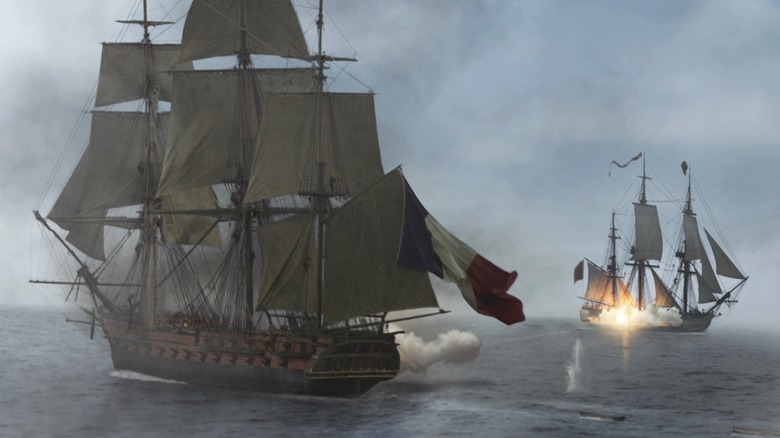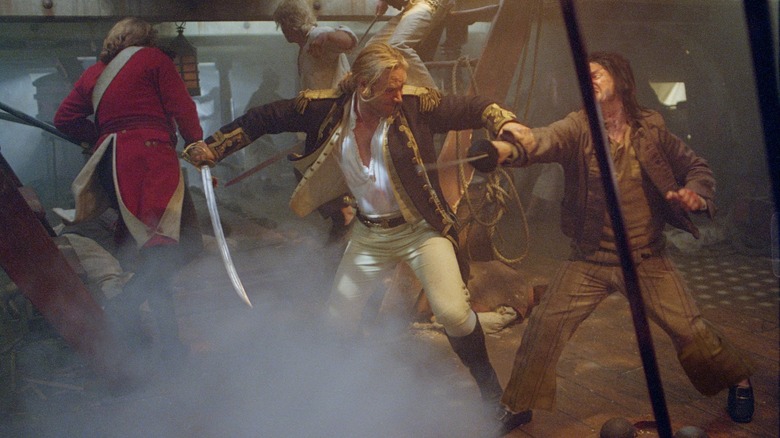The Ship-To-Ship Battle In Master And Commander: The Far Side Of The World Is The Best Action Scene Ever
(Welcome to Best Action Scene Ever, a column dedicated to breaking down the best, most effective action sequences throughout the genre. In this edition, we're hoisting our flags and setting sail to dive into the climactic naval battle in "Master and Commander: The Far Side of the World" ... subject to the requirements of the service, of course.)
Ask me for a movie genre that best exemplifies filmmaking done right on every level — particularly in the most fundamental aspects — and chances are I'm showing you a highly-acclaimed historical epic. There's just something about the incredibly vast canvass afforded by these sweeping, big-budget stories that lend themselves to an attention to detail rarely matched by any other production. If one of the goals of cinema is complete immersion, then few can even hope to compare to the sense of texture and immediacy provided by these period pieces. Dialogue tends to take on a more poetic and lyrical cadence, the production design team goes above and beyond to transport audiences to a world far removed from our own, and the actual storytelling approach somehow feels more honed in — though never at the expense of delivering on the popcorn entertainment that most audiences crave.
Director Peter Weir's "Master and Commander: The Far Side of the World" checks every box, operating as more of a steady and deliberate slow-burn chronicling the wartime efforts of Captain "Lucky Jack" Aubrey (Russell Crowe), his best friend and doctor Stephen Maturin (Paul Bettany), and the crew of the British warship, the HMS Surprise. Their target? The French privateer the Acheron, commanded by a wily captain who leads the Surprise on a cat-and-mouse chase across the seas. For most of its runtime, the film is surprisingly light on the action ... until its final act.
The scene
Newcomers might be surprised to find out just how episodic in structure "Master and Commander" proves to be, walking viewers through a series of relatively self-contained vignettes that all add up to a living, breathing portrait of life on the seas during the early 1800s. With the Acheron essentially a ghost for entire stretches of the runtime, we instead spend all of our time with the ramshackle crew of the Surprise — predominantly the Captain and the doctor, whose diametrically opposite personalities are tested again and again by their conflicting roles on the ship. The end result means that the picture feels more like a character study and a suspense/thriller than an all-out war film, but its impressively reserved nature makes the inevitable battle to come hit all the harder.
That confrontation finally arrives in an unexpected way. Urging the crew to live up to their ship's name, Captain Aubrey issues his clever orders: dress up the Surprise as a whaling ship — a known target of the Acheron — and wait for their chance. After drawing the faster and more formidable enemy into the heart of their trap, the sailors throw off their disguises and enter the fray. Punctuated by bursts of cannon fire and dense smoke between the dueling ships, the masterfully staged battle gives Weir, cinematographer Russell Boyd, and editor Lee Smith the opportunity to flex their action muscles. Viewers get a hefty dose of close-quarters combat alternating with clarifying (not to mention downright painterly) establishing shots from a distance, ensuring we never lose track of geography.
The ultimate effect gives viewers a harrowing, boots-on-the-ground perspective on the horrors of war.
Why it works
It's all about the buildup. Peter Weir is hardly a stranger to taking his time and comprehensively establishing the nuts and bolts of a feature, carefully laying the groundwork for when the fireworks eventually go off. That approach pays off brilliantly with his adaptation of Patrick O'Brian's novel (the screenplay is credited to Weir and co-writer John Collee). As much as the early portions of the film may test the patience of anyone expecting the battles to come early and often — the opening epigraph famously proclaims that "Oceans are now battlefields," after all — there turns out to be a method to the madness.
After the opening sneak attack by the Acheron, the film soon settles into a much more measured pace that focuses on repairs (both to ship and sailor, as young Midshipman Blakeney learns when his arm requires amputation), strategy, and the daily life of a sailor on a ship at sea. Every scene with Jack and Stephen practicing classical and baroque musical compositions, painfully hilarious dad jokes about weevils, and the intricacies of officer hierarchy among the crew all add crucial layers to a crew that could've easily retreated into the background. Instead, the filmmakers weave each and every supporting player into the broader conflict between Britain and France, giving us a sense of the sailing vessel at times other than war. That way, we know what stands to be lost once the bullets start flying.
As for the action itself, the clear and concise camerawork successfully places the viewer directly into the shoes of our heroes — not heightened and cartoonish like "Pirates of the Caribbean" or comparable to the glorifying valor of "The Lord of the Rings" — but in a way that shows just how awful and horrific war really is.
The key moment
It should come as no surprise that Weir manages to find time and space to sprinkle in character moments amid the action, paying off on an entire movie's worth of setup. After carefully learning from Aubrey's leadership throughout the film, second-in-command Lieutenant Tom Pullings (James D'Arcy) gets his moment to shine in the battle, fully earning his commendation to captaincy once the Acheron is taken. Other minor characters receive their own tragic ends, either as fateful comeuppance for past misdeeds (as it turns out, driving an officer to suicide out of some misplaced superstition about the Biblical figure Jonah and the bad luck certain individuals bring to a sailing ship ends in death) or as an example of a life cut far too short by human cruelty. Even the ever-curious Blakeney, often paired with the good doctor in a wonderful match of peace-loving interests, is forced to grow up and bravely lead his own command into the thick of battle.
All of these moments help deepen the worldbuilding of the film and make us that much more invested in a never-ending chase that may not even seem all that significant in the big picture. But because the characters have little other focus than the mission at hand, particularly the obsessive Aubrey, so do we. Weir never once takes a step back to shatter our immersion and drain the story of all its tension, but instead keeps us claustrophobically confined to the ship. Only a brief stay at the Galápagos Islands, itself an important character moment between a wounded Stephen and a relentlessly duty-bound Jack, gives us a much-needed breather from the ongoing war.
In the end, "Master and Commander" succeeds by giving us a reason to care. The final battle is living proof of that.


